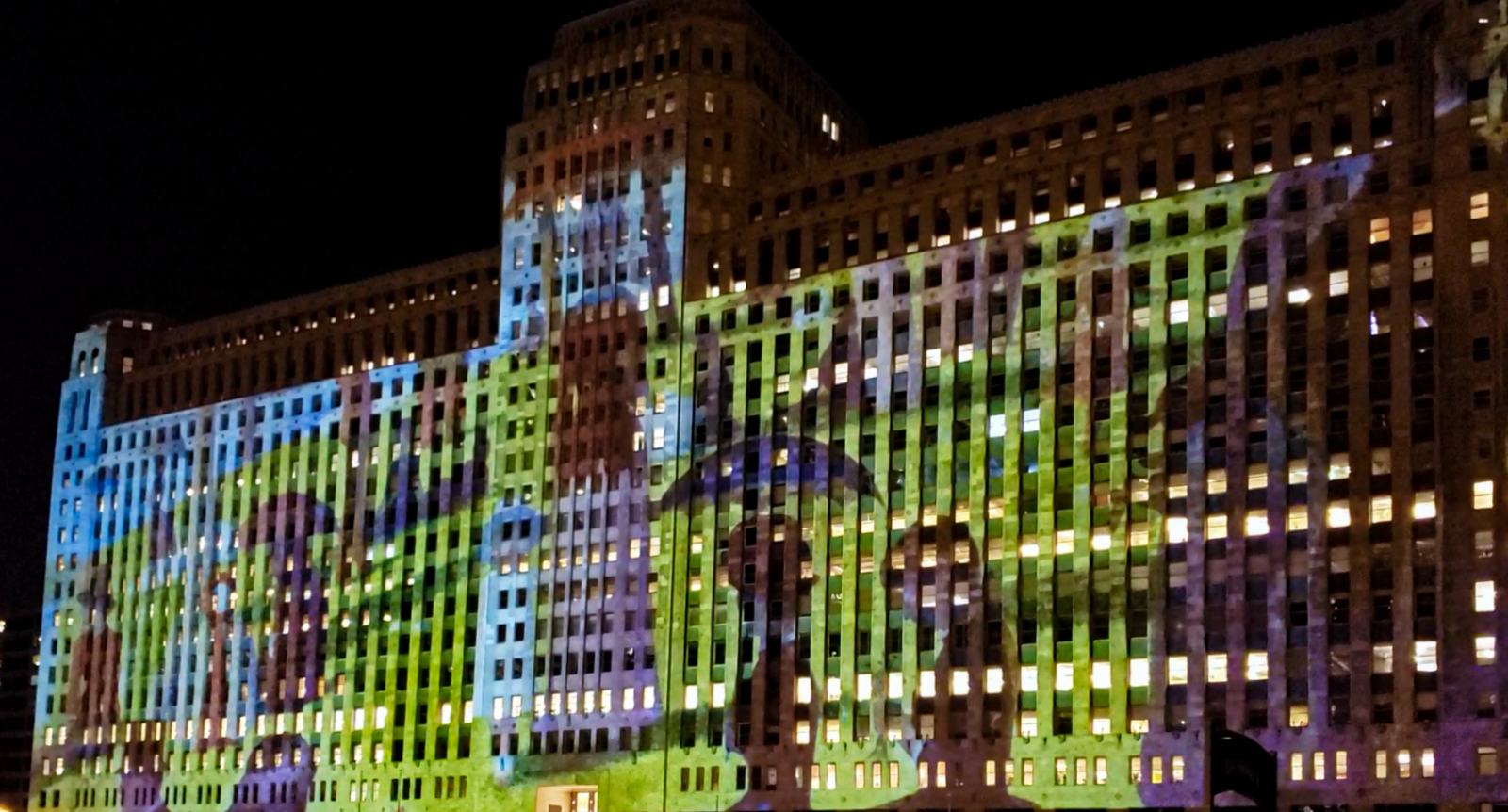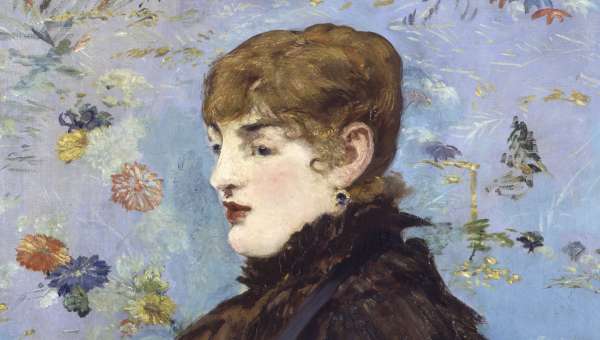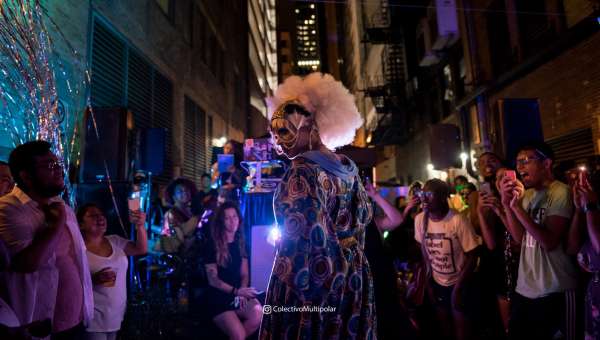Posted 6 years ago in Arts and Culture, Trending, Family Friendly
Art on theMART, the largest permanent digital art projection in the world, is now projecting four iconic artworks from the Art Institute of Chicago’s permanent collection across the 2.5-acre river-façade of theMART (formerly Merchandise Mart).
The artworks, Georgia O’Keeffe’s Yellow Hickory Leaves with Daisy, Georges-Pierre Seurat’s A Sunday on La Grande Jatte—1884, Vincent van Gogh’s The Bedroom, and Grant Wood’s American Gothic will join the current Summer Program. Since August 1, the artworks have been on view for two hours nightly beginning approximately 30 minutes after sunset.
“We are honored to work with the Art Institute of Chicago to offer unprecedented access to four beloved, yet transformed, works from the permanent collection,” said Art on theMART Executive Director Cynthia Noble. “This collaboration exemplifies the mission of our program, which is, in part, to provide a public art platform for leading cultural institutions and artists to create engaging new media experiences for all visitors.”
The partnership enables these masterpieces to be seen by the thousands of locals and visitors traversing downtown Chicago and the Chicago Riverwalk each evening.
“The Art Institute is thrilled to share some of our most iconic works with the city through our partnership with theMART- a landmark architectural site and a new platform for public art in Chicago,” said Robyn Farrell, Art Institute of Chicago Assistant Curator of Contemporary Art. “Our collaboration with Art on theMART provides an exciting opportunity to engage residents and visitors within the city's vibrant landscape.”

Photo credit: Georgia O’Keeffe. Yellow Hickory Leaves with Daisy, 1928. Alfred Stieglitz Collection, a gift of Georgia O’Keeffe. Courtesy of the Art Institute of Chicago.
A Sunday on La Grande Jatte—1884 by Georges-Pierre Seurat (1884-9)
“Bedlam,” “scandal” and “hilarity” were among the epithets used to describe what is now considered Georges Seurat’s greatest work, and one of the most remarkable paintings of the nineteenth century when it was first exhibited in Paris. Seurat labored extensively over A Sunday on La Grande Jatte—1884, reworking the original as well as completing numerous preliminary drawings and oil sketches (the Art Institute has one such sketch and two drawings). With what resembles scientific precision, the artist tackled the issues of color, light, and form. Inspired by research in optical and color theory, he juxtaposed tiny dabs of colors that, through optical blending, form a single and, he believed, more brilliantly luminous hue. To make the experience of the painting even more intense, he surrounded the canvas with a frame of painted dashes and dots, which he, in turn, enclosed with a pure white wood frame, similar to the one with which the painting is exhibited today. The very immobility of the figures and the shadows they cast makes them forever silent and enigmatic. Like all great masterpieces, La Grande Jatte continues to fascinate and elude.

Photo credit: Georges-Pierre Seurat, French, 1859-1891. A Sunday on La Grande Jatte—1884, 1884–86, painted border 1888/89. The Art Institute of Chicago, Helen Birch Bartlett Memorial Collection.
The Bedroom by Vincent van Gogh (1889)
Vincent van Gogh so highly esteemed his bedroom painting that he made three distinct versions: the first, now in the collection of the Van Gogh Museum, Amsterdam; the second, belonging to the Art Institute of Chicago, painted a year later on the same scale and almost identical; and a third, smaller canvas in the collection of the Musée d’Orsay, Paris, which he made as a gift for his mother and sister. Van Gogh conceived the first Bedroom in October 1888, a month after he moved into his “Yellow House” in Arles, France. This moment marked the first time the artist had a home of his own, and he had immediately and enthusiastically set about decorating, painting a suite of canvases to fill the walls. Completely exhausted from the effort, he spent two-and-a-half days in bed and was then inspired to create a painting of his bedroom. As he wrote to his brother Theo, “It amused me enormously doing this bare interior. With a simplicity à la Seurat. In flat tints, but coarsely brushed in full impasto, the walls pale lilac, the floor in a broken and faded red, the chairs and the bed chrome yellow, the pillows and the sheet very pale lemon green, the bedspread blood-red, the dressing-table orange, the washbasin blue, the window green. I had wished to express utter repose with all these very different tones.” Although the picture symbolized relaxation and peace to the artist, to our eyes, the canvas seems to teem with nervous energy, instability, and turmoil, an effect heightened by the sharply receding perspective.

Photo credit: Vincent van Gogh. The Bedroom, 1889. Helen Birch Bartlett Memorial Collection. Courtesy of the Art Institute of Chicago.
American Gothic by Grant Wood (1930)
This familiar image was exhibited publicly for the first time at the Art Institute of Chicago, winning a three-hundred-dollar prize and instant fame for Grant Wood. The impetus for the painting came while Wood was visiting the small town of Eldon in his native Iowa. There he spotted a little wood farmhouse, with a single oversized window, made in a style called Carpenter Gothic. “I imagined American Gothic people with their faces stretched out long to go with this American Gothic house,” he said. He used his sister and his dentist as models for a farmer and his daughter, dressing them as if they were “tintypes from my old family album.” The highly detailed, polished style and the rigid frontality of the two figures were inspired by Flemish Renaissance art, which Wood studied during his travels to Europe between 1920 and 1928. After returning to settle in Iowa, he became increasingly appreciative of midwestern traditions and culture, which he celebrated in works such as this. American Gothic, often understood as a satirical comment on the midwestern character, quickly became one of America’s most famous paintings and is now firmly entrenched in the nation’s popular culture. Yet Wood intended it to be a positive statement about rural American values, an image of reassurance at a time of great dislocation and disillusionment. The man and woman, in their solid and well-crafted world, with all their strengths and weaknesses, represent survivors.

Photo credit: Grant Wood, American, 1891-1942. American Gothic, 1930. The Art Institute of Chicago. Friends of American Art Collection.


